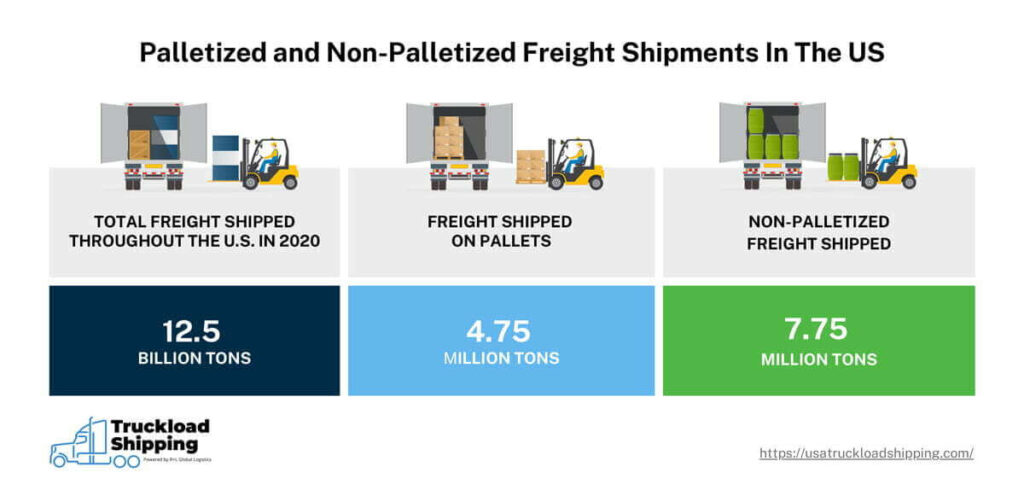One of the most common items in the freight shipping industry is the simple pallet. Pallets have been in use for more than 80 years and are used to load and organize freight for shipping. However, a good portion of goods shipped in the U.S. are classified as non-palletized freight.
Key takeaways:
In this article, we will discuss everything that you need to know about shipping non-palletized freight.
Non-palletized freight is also referred to as floor-loaded freight and constitutes any type of cargo that is not secured by a pallet. In the next two sections, we’ll discuss the pros and cons of shipping this kind of cargo.
Numerous benefits come with shipping freight without using a pallet.
These include:
While pallets are reusable for multiple shipments, there are upfront and repair costs you’ll have to pay. You can avoid these expenses when your floor load cargo.
Non-palletized freight uses up less space in a trailer. How so?
It’s loaded from floor to ceiling, which utilizes all the space available in a trailer or container. By maximizing space, multiple non-palletized freight shipments can share the same trailer or container.
Some boxes can be too awkwardly shaped to fit on a pallet. Not using a platform will be more beneficial for this variety of items, as you will have access to more flexible loading options.
You won’t need to purchase or maintain pallet jacks and forklifts when you ship floor loaded freight. This will also help you save on additional expenses
Related: Pallet Requirements for International Shipments
There are a few downsides to floor-loaded shipments that you should know about.
Fragile cargo isn’t well-suited for floor-loaded shipping. Without the security a pallet can offer, it will be more likely to sustain damage
While shipping costs for palletless freight might be cheaper, labor costs are likely to be higher. The loading and unloading of non-palletized freight has to be done by hand. Unfortunately, handling the freight manually makes the loading and unloading a much longer process. As a result, receiving and logging in stock takes longer as well.
Heavier products that are shipped without pallets are especially difficult to load and unload. A non-palletized shipment shouldn’t be heavier than 130 pounds.
If you are planning to ship freight that exceeds this weight limit, then you should consider placing it on a pallet.
Related: Shipping Skid vs Pallet
Shipping freight without a pallet might seem reckless. However, non-palletized freight is fairly common in the shipping industry.
In 2020, there was about 12.5 billion tons of freight shipped nationwide and about 1.9 billion of shipping pallets were used. The standard pallet can carry a little over two and a half tons.
That means 4.75 billion tons of freight distributed by 1.9 billion shipping pallets annually. This means that the rest of the 7.75 billion tons that travels the nation is shipped as non-palletized freight.

Keep in mind, many non-palletized freight shipments are for small-parcel delivery. Therefore, you should consider using a pallet if you’re shipping larger loads sent to warehouses or supermarkets.
Loading non-palletized freight requires the utmost care. Since products aren’t secured by a pallet, there is a higher likelihood that they can bounce around and get damaged inside a trailer or container.
This can be difficult because loose freight can vary in size, shape, and weight. This can make proper stacking and securing a challenge. Loading should be done with extra care.
As we mentioned earlier, non-palletized freight is loaded into containers and trailers from floor to ceiling. While loading freight in this manner might sound self-explanatory, there are still important steps that need to be followed to ensure the freight is loaded properly.
The guidelines for loading non-palletized freight may differ based on the company receiving the load, but they will roughly follow the steps we’ve listed.
Whatever the exact requirements are, make sure you follow them correctly. Non-palletized freight that’s loaded improperly could potentially fall on dockworkers. Items inside the packages may sustain damage as well.
Non-palletized cargo is shipped the same way that palletized cargo is. Non-palletized freight can travel by ship, plane, cargo containers, trailers and by train. Another popular method of transport for non-palletized freight that most people have experienced is by a delivery truck.
If you need to ship freight in bulk, USA Truckload can help by partnering you with a reliable carrier. We have a vast network of transportation providers all over the country. They’ll be able to pick up your freight from a location of your choosing and move it to the final destination. When you pick USA Truckload, you’ll also get access to a variety of shipping services.
Start your partnership with USA Truckload today by filling out your Request for Proposal (RFP). Our team is also available at (866) 353-7178 if you have any questions about the services we provide.
R+L Global Logistics
315 NE 14th St., Ocala, FL 34470
Hello,
I’m trying to ship a large piece of brewing equipment that measures about 5 ft x 5 ft x 5 ft and weighs 370 lbs. It is on casters and not on a pallet.
Ship from:
Guinness Open Gate Brewery Chicago
Megan Schwarz
901 West Kinzie
Chicago, IL 60607
Lift gate required.
Ryder Warehouse
Attn: Mike Stolarek BTC TAX PAID CAGE
1701 Remington Blvd
Bolingbrook, IL 60490
Needs to be off loaded at a standard dock door.
Can you assist with this?